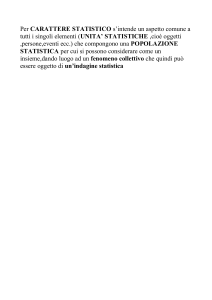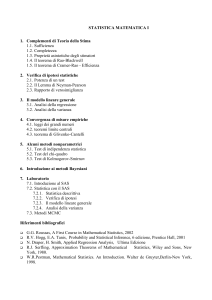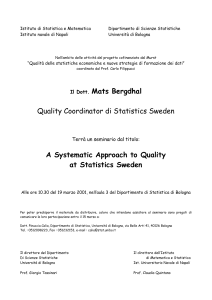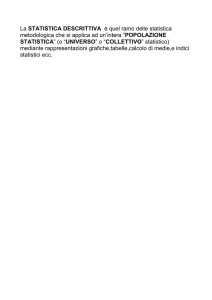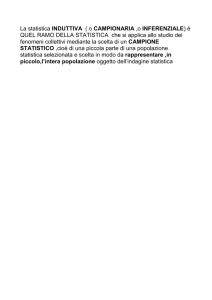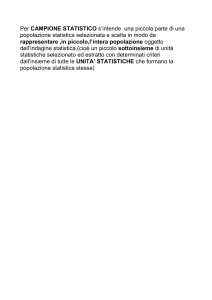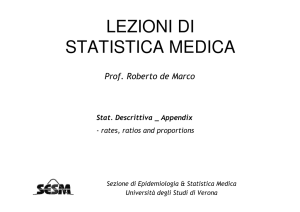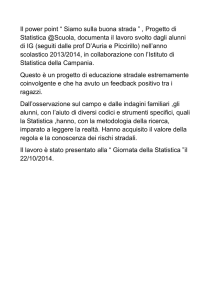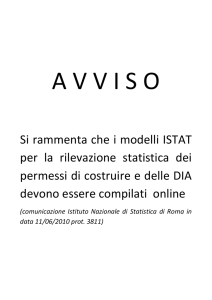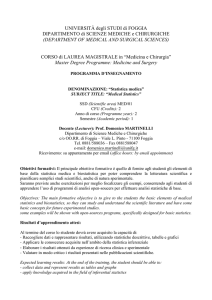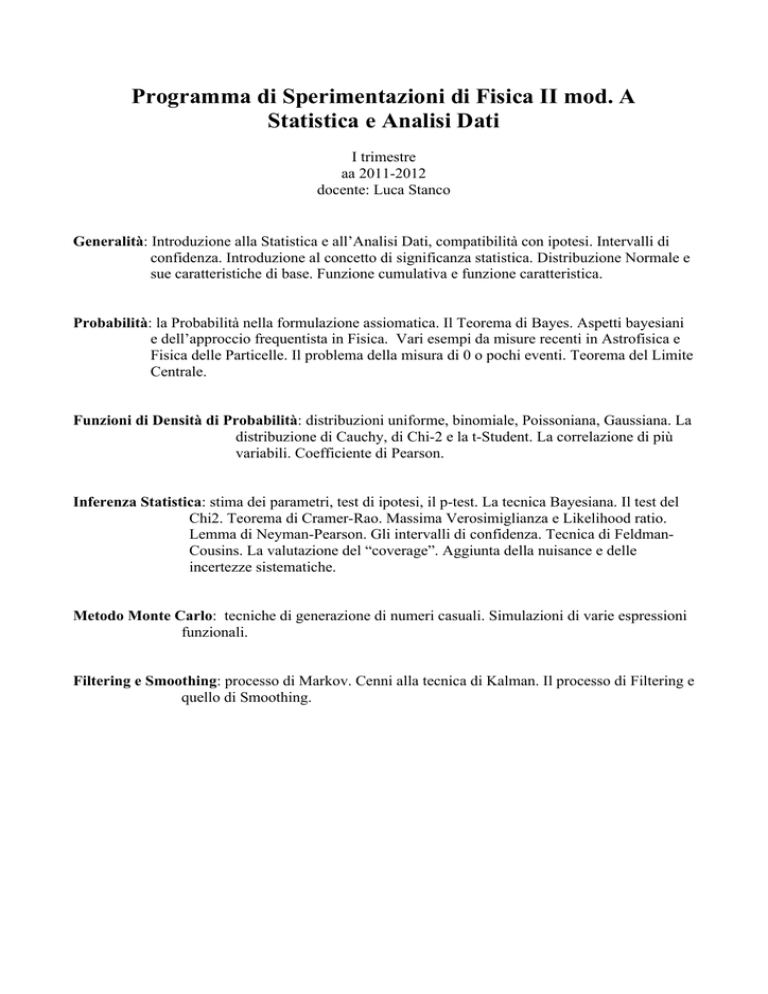
Programma di Sperimentazioni di Fisica II mod. A
Statistica e Analisi Dati
I trimestre
aa 2011-2012
docente: Luca Stanco
Generalità: Introduzione alla Statistica e all’Analisi Dati, compatibilità con ipotesi. Intervalli di
confidenza. Introduzione al concetto di significanza statistica. Distribuzione Normale e
sue caratteristiche di base. Funzione cumulativa e funzione caratteristica.
Probabilità: la Probabilità nella formulazione assiomatica. Il Teorema di Bayes. Aspetti bayesiani
e dell’approccio frequentista in Fisica. Vari esempi da misure recenti in Astrofisica e
Fisica delle Particelle. Il problema della misura di 0 o pochi eventi. Teorema del Limite
Centrale.
Funzioni di Densità di Probabilità: distribuzioni uniforme, binomiale, Poissoniana, Gaussiana. La
distribuzione di Cauchy, di Chi-2 e la t-Student. La correlazione di più
variabili. Coefficiente di Pearson.
Inferenza Statistica: stima dei parametri, test di ipotesi, il p-test. La tecnica Bayesiana. Il test del
Chi2. Teorema di Cramer-Rao. Massima Verosimiglianza e Likelihood ratio.
Lemma di Neyman-Pearson. Gli intervalli di confidenza. Tecnica di FeldmanCousins. La valutazione del “coverage”. Aggiunta della nuisance e delle
incertezze sistematiche.
Metodo Monte Carlo: tecniche di generazione di numeri casuali. Simulazioni di varie espressioni
funzionali.
Filtering e Smoothing: processo di Markov. Cenni alla tecnica di Kalman. Il processo di Filtering e
quello di Smoothing.
Modalità di esame
Orale.
Parole Chiave
Fisica sperimentale; elaborazione dati, probabilità, statistica, test di ipotesi, Monte Carlo.
Riferimenti
Il materiale è organizzato in modo originale dal Docente. All’inizio del corso saranno disponibili
parti del libro che sta preparando il Docente.
Molto materiale è stato comunque estratto dai seguenti siti online:
Parti formali da “Teoria degli errori e fondamenti di statistica” by Maurizio Loreti, disponibile al
seguente link: http://wwwcdf.pd.infn.it/labo/INDEX.html
Introduzione alla Probabilità da Larry Gonick & Woollcott Smith, “The cartoon guide to Statistics”
Letture suggerite: G. D’Agostini pagina web, http://www-zeus.roma1.infn.it/~dagos/prob+stat.html
Lecture di Statistica di Kyle Cranmer, CERN Academic Training, Feb. 2009 in
http://indico.cern.ch/conferenceDisplay.py?confId=48425 e pagine web seguenti.
Louis Lyons, Gran Sasso Lectures, Sep. 2010
http://cfa.lngs.infn.it/seminars/practical-statistics-for-experimental-scientists
Un ottimo testo di riferimento per tutto il Corso di Laurea è il seguente:
L. Wasserman, “All of Statistics. A Concise Course in Statistical Inference”, Springer, ed. 2004.
English version
Introduction: Statistics and Data Analysis, compatibility with hypothesis. Ranges of Confidence.
Introduction to the concept of statistical significance. Normal distribution and its
fundamental characteristics. Cumulative function and Characteristics function.
Probability: Probability in its axiomatic formulation. The Bayes theorem. Bayesian aspects and the
frequentist approach in Physics. Some recent Astrophysics and Particle Physics. The
problem of the measurement of 0 or very few events. The Central Limit theorem.
Probability Density Functions:: the uniform distribution, the binomial, the Poissonian and the
Gaussian ones. The Cauchy distribution, the Chi2 and the t-Student.
Correlation of several random variables. Pearson coefficient.
Statistics Inference: estimation of parameters, test of hypothesis, the p-test. The Bayesian
technique. Chi2-test. The theorem of Cramer-Rao. Maximum likelihood and
likelihood ratio. Lemma of Neyman-Pearson. Confidence intervals. Technique of
Feldman-Cousins. Evaluation of the “coverage”. Adding the nuisance and
systematic uncertainties.
Monte Carlo method: technicalities in the generation of random numbers. Simulations of several
functional relations.
Filtering and Smoothing: the Markov process. The Kalman technique. The Filtering and the
Smoothing procedures.
Examination
Oral test.
Keywords
Experimental physics; data analysis, statistics, testing of hypothesis, Monte Carlo.
Bibliography
Material is originally organized by the Teacher. At the beginning of the course some parts of the
book under preparation by the Teacher will be made available.
Anyhow most of it is taken from the following online sites:
Formal parts from “Teoria degli errori e fondamenti di statistica” by Maurizio Loreti, available at
the following link: http://wwwcdf.pd.infn.it/labo/INDEX.html
Probability introduction as in Larry Gonick & Woollcott Smith, “The cartoon guide to Statistics”
Suggested reading: G. D’Agostini web page, http://www-zeus.roma1.infn.it/~dagos/prob+stat.html
Lectures on Statistics by Kyle Cranmer, CERN Academic Training, Feb. 2009 in
http://indico.cern.ch/conferenceDisplay.py?confId=48425 and following web pages.
Louis Lyons, Gran Sasso Lectures, Sep. 2010
http://cfa.lngs.infn.it/seminars/practical-statistics-for-experimental-scientists
An excellent book valid for the whole Course in Physics is the following:
L. Wasserman, “All of Statistics. A Concise Course in Statistical Inference”, Springer, ed. 2004.

